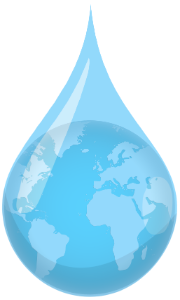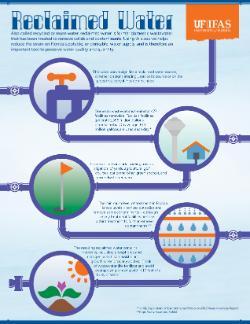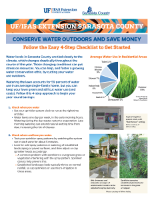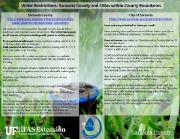
Reclaimed Water
What happens to water once it's used? Well, wastewater can be recycled in a variety of ways to help cut down on the environmental and financial costs of producing and distributing fresh, potable water. Recycled wastewater, otherwise known as reclaimed water, is a pillar in water conservation, as it allows us to get more use out of a nonrenewable and crucial resource.
Sarasota County reuses around 65-70 percent* of its wastewater (compared to a Florida-wide average of 34 percent), and has set a goal of using 75 percent by 2040.
Major reclaimed water customers include the agricultural industry and golf courses. However, more and more residents are provided reclaimed water for lawn and landscape irrigation. The following table shows how much reclaimed water a typical customer could use on their land using a standard application rate of 0.5 inches per week.
Potential for reclaimed water by land use type
| Land Use Type | Irrigable Percentage |
|---|---|
| Agriculture | 90% |
| Golf Course | 70% |
| Residential (moderate- to high-density) | 60% |
| Residential (low-density)1 | 30% |
| Commercial/Light Industrial | 20% |
The table, taken from the Sarasota County Reclaimed Water Master Plan, showcases the potential need for more reclaimed water in years to come. Outside of direct customers, reclaimed water has great use in filling infiltration and holding ponds as well as for use in cooling towers. See the pie chart below from the Florida Department of Environmental Protection to find out the most common uses of reclaimed water.
Reclaimed Water Utilization by Flow
Treatment
Before wastewater can be used as reclaimed water, it is put through a series of treatments. For most of Florida, secondary treatment is required. In specific southwest Florida counties, tertiary treatment or advanced wastewater treatment (AWT) is required if the water is being discharged to surface waters. AWT is conducted to further filter out nutrients from the water.
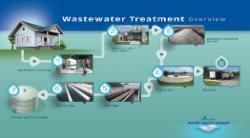 Wastewater treatment in Sarasota County goes through an 8-step process before it is distributed to customers as reclaimed water. Treatment involves the removal of solid waste, bacterial activation, sand filtration and disinfection/chlorination. Even with this extensive treatment, reclaimed water is not recommended for drinking, washing cars, or irrigating home gardens with edible plants (that cannot be cooked or peeled). This is because it is known to contain constituents of concern.
Wastewater treatment in Sarasota County goes through an 8-step process before it is distributed to customers as reclaimed water. Treatment involves the removal of solid waste, bacterial activation, sand filtration and disinfection/chlorination. Even with this extensive treatment, reclaimed water is not recommended for drinking, washing cars, or irrigating home gardens with edible plants (that cannot be cooked or peeled). This is because it is known to contain constituents of concern.
Nutrients
Reclaimed water contains a certain amount of nutrients, meaning that extra care must be taken to make efficient use when watering. Overwatering your lawn has consequences regardless of your source of irrigation water. Overwatering causes leaching, allowing nutrients to travel through shallow, underground pore spaces down to the nearest waterbody. These leached nutrients can exacerbate water quality issues and lead to algae blooms. The salt content in reclaimed water can also make it difficult to use on certain plant species. According to UF research, plants that tend to react poorly to salt include azaleas (Rhododendron species) and crepe myrtles (Lagerstroemia species).
Purple Pipes
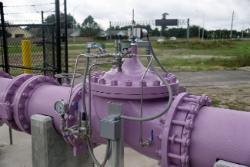 So, how do you know where reclaimed water is being used? Purple is the designated color for a reclaimed water pipeline! If you see a purple pipe, chances are it is doing good for the community and the regional water supply.
So, how do you know where reclaimed water is being used? Purple is the designated color for a reclaimed water pipeline! If you see a purple pipe, chances are it is doing good for the community and the regional water supply.
Reclaimed Water in Sarasota County
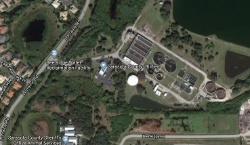 Sarasota County is making strides in using reclaimed water for irrigation. In 2018, Sarasota County treated a total of 5.1 billion gallons of wastewater county-wide. Our county does a good job of using reclaimed water and is actively improving the process. Unfortunately, unused reclaimed water can be an issue. The Bee Ridge Water Reclamation Facility (one of three main county facilities) sometimes produces more reclaimed water than is used by residents, especially in the rainy season. At Bee Ridge, this extra reclaimed water has discharged off-site when its storage pond is full. Although the water is safe for irrigation, this situation is not ideal.
Sarasota County is making strides in using reclaimed water for irrigation. In 2018, Sarasota County treated a total of 5.1 billion gallons of wastewater county-wide. Our county does a good job of using reclaimed water and is actively improving the process. Unfortunately, unused reclaimed water can be an issue. The Bee Ridge Water Reclamation Facility (one of three main county facilities) sometimes produces more reclaimed water than is used by residents, especially in the rainy season. At Bee Ridge, this extra reclaimed water has discharged off-site when its storage pond is full. Although the water is safe for irrigation, this situation is not ideal.
Thankfully, Sarasota is working with the Florida Dept. of Environmental Protection on introducing advanced wastewater treatment (AWT) to the Bee Ridge facility by 2025. AWT removes nitrogen and phosphorus from reclaimed water. This will make reclaimed water safer to release to downstream waters and gives it more potential for future applications. The county is also currently working on transferring excess water to a well at the Central County water reclamation facility, diverting wastewater flows to Central County, and reducing inflow during storms. More long-term solutions include creating two aquifer recharge wells at the Bee Ridge facility and increasing the amount of reclaimed water users.
Though there are some areas where reclaimed water distribution needs improvement, there is no doubt that it relieves great pressure from our local freshwater systems and allows us to reuse a very valuable resource. In this way, it is essential in our ongoing water conservation efforts.
Reclaimed Water Map
Curious to know where reclaimed water pipelines exist near you? Check out the following map from the Southwest Florida Water Management District:
Additionally, Sarasota County residents should take care not to purchase fertilizer that contains phosphorus. In many cases, Florida soil already has enough naturally occurring phosphorus. If you are curious about your yard’s soil, you can always arrange a soil test through UF/IFAS Extension Sarasota County.
Managing your fertilizer input effectively will also depend on your source of reclaimed water. Different water reclamation facilities (WRF) will have different nitrogen concentrations in their finished product.
Are you a reclaimed water customer in Sarasota County? Use one of our Bay-Friendly Fertilizing Tools below to adjust your fertilizer use based on your reclaimed water's nutrients.
Bay-Friendly Fertilizing Tools
You can help cut down on leaching and save our waters by fertilizing responsibly. To help you calculate how much nitrogen-based fertilizer your turf needs, use one of our Bay-Friendly Fertilizing tools below.
Select the tool that best represents your turf type.
Resources
- Reclaimed Water Use in the Landscape: Frequently Asked Questions about Reclaimed Water
- Reclaimed Water: Frequently Asked Questions
- Reclaimed Water Use in the Landscape: Constituents of Concern in Reclaimed Water
Blogs
Learn More
Make the Pledge
- Aerator pledge (PDF)
- Showerhead pledge (PDF)
